- Home
- >
- Negative Vectors – Explanation and Examples
JUMP TO TOPIC
Negative Vectors – Explanation & Examples
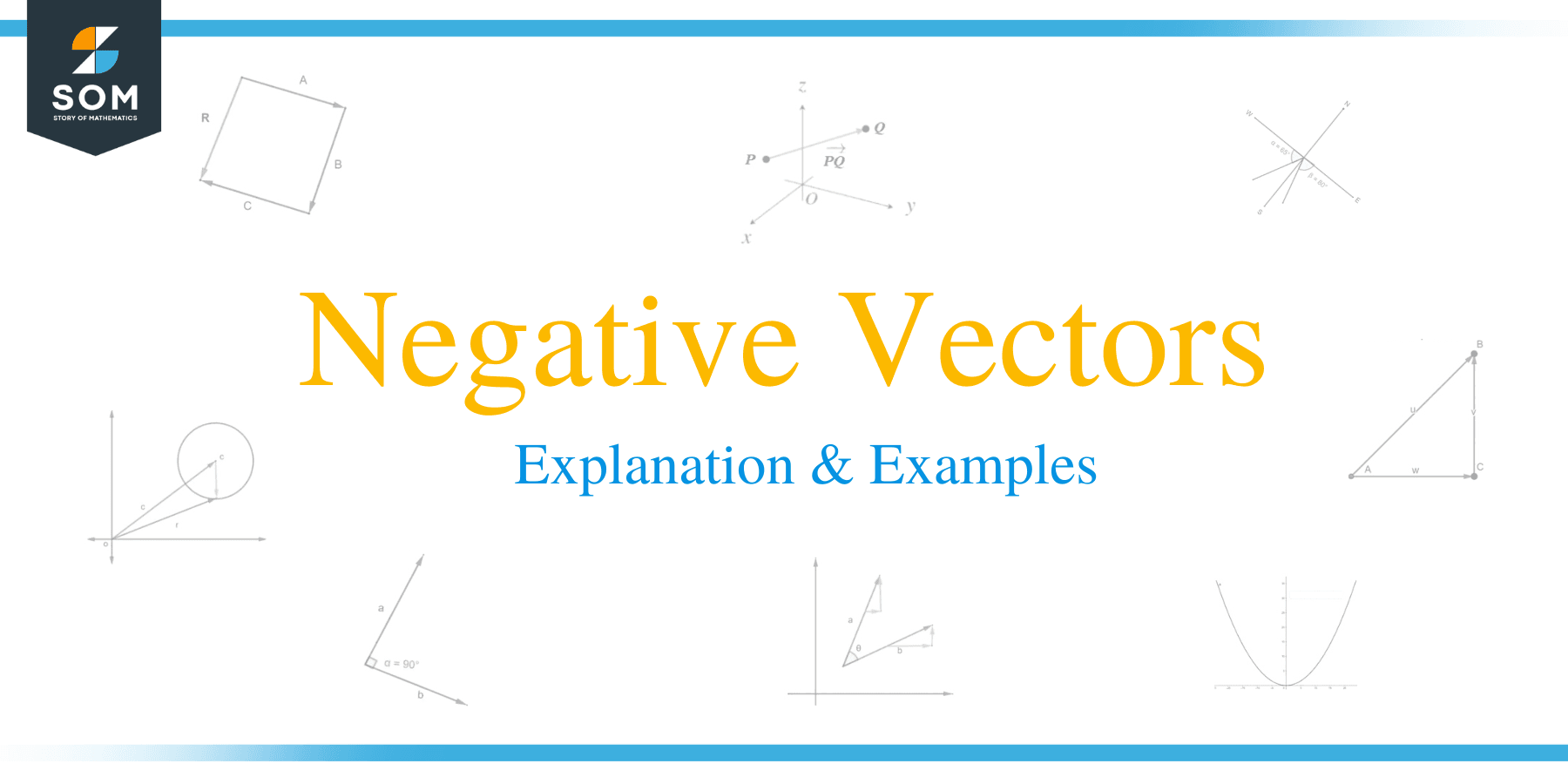 If there are negative scalars, is it also possible to have a negative vector? It is! In fact, a negative vector is:
If there are negative scalars, is it also possible to have a negative vector? It is! In fact, a negative vector is:
“A vector whose magnitude is the same as that of the reference vector, but its direction is opposite to that of the reference vector.”
In this article, we will discuss the following subtopics related to negative vectors:
- What is the Negative of a Vector?
- How to Find a Negative Vector
What is the Negative of a Vector?
Vectors having the same length as a particular vector but in the opposite direction are called negative vectors. A negative sign will reverse the direction of a vector and make it a negative vector. Vectors are only negative with respect to another vector.
For example, if a vector PQ points from left to right, then the vector QP will point from right to left. Since these directions are opposite, we say that PQ = –QP. That is, QP is the negative vector for PQ, as depicted in the image below. It is important to note that the vector PQ and the vector QP have the same magnitude but opposite directions, making them the negative vectors of each other.
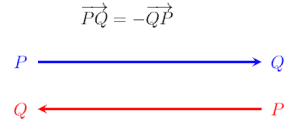
The magnitude, or length, of a vector, cannot be negative; it can be either be zero or positive. The negative sign is used here to indicate that the vector has the opposite direction of the reference vector.
Mathematically, we can say that two vectors A and B are the negatives of each other if they satisfy the following two conditions:
A = –B (“Vector B is negative of vector A”)
If
|A| = |B| (Equal magnitude) and
A ↑ and B ↓ or A↓ and B ↑ (Opposite directions).
Another simple method to find out if two vectors are the negatives of each other is to compare their coordinates. If the vectors’ coordinates are equal in value but have opposite signs, the vectors will be the negatives of each other. For example, consider the vectors A = (ax1, ay1) and B = (bx1, by1). We say that the vector B is the negative of vector A, or:
A = –B
If
ax1 = -bx1 and ay1 = -by1.
This criterion is enough to show that B is the negative vector of A and vice versa.
How to Find a Negative Vector?
The basic idea behind finding the negative vector of a given vector is to find the two components of the given vector (i.e., the vector’s magnitude and the direction) and then find a vector of the same length that points in the opposite direction. Two such vectors will be the negative vectors of each other.
Finding the negative vector of a given vector can be done by placing a negative sign in front of it. For example, let X be a vector. To obtain X’s negative vector, we multiply X by -1, making it –X. Remember that the magnitude of vector –X is the same as that of vector X.
Examples
This section will first consider different examples where we find negative vectors by comparing the reference vector’s components. We will then discuss some more examples and their step-by-step solutions to develop an even deeper understanding of negative vectors.
Example 1
Given the vector P = (2, 4), determine the negative of P.
Solution
By definition, the negative of a vector has the same magnitude as the reference vector’s opposite direction. In this case, the reference vector is P, and its direction is 2 points to the right along the x-axis and 4 points upward along the y-axis. Thus, to find P’s negative vector, we keep the same magnitude and multiply the reference vector P by -1. This gives us:
–P = (-2,-4)
Or
– P = – (2, 4)
Now, the negative vector’s direction can be interpreted as 2 points to the left along the x-axis and 4 points downward along the y-axis. This is clearly opposite to the direction of reference vector P.
Example 2
Given the parallelogram ABCD in the image below, determine which vectors are equal to each other and the negatives of each other.
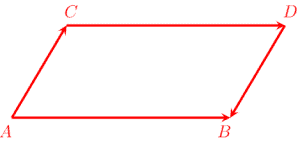
Solution
By definition, two vectors can be equal only if they have the same magnitude and point in the same direction. In the parallelogram ABCD, the vector AB is parallel to the vector CD, whereas the vector BC is parallel to the vector DA. Also, the vector AB and the vector CD point in the same direction. Therefore, we can say that they are equal vectors, i.e.:
AB = CD (Equal vectors)
Similarly, the vector BC and the vector DA have the same length but opposite directions. Therefore they are negative of each other, i.e.:
BC = –DA (Negative vectors)
Example 3
Consider the image given below. Compare the two vectors P and Q and determine if they are the negatives of each other or not.
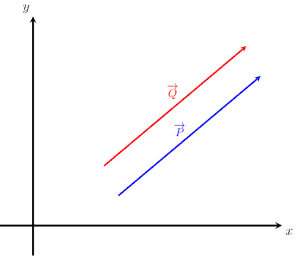
Solution
This example is straightforward. From the above image, it can be seen that the vector P and vector Q have the same magnitude. The two vectors are also pointing in the same direction. Therefore, a quick comparison of the two vectors shows that they are equal, but they are not the negatives of each other.
P = Q
Example 4
Determine the negative of the vector OW, the initial point of which is O = (2, 5) and the final point of which is W = (5, 2).
Solution
To determine the negative of the given vector OW, we multiply its coordinates by -1 to get – OW. Thus, the initial and final points of the negative vector are:
-O = (-2, -5) and -W = (-5, -2)
Next, we determine the magnitude of both the vectors to check that they are still the same.
The magnitude is computed as follows:
|OW| = √ (5 – 2)^2 + (2 – 5)^2
|OW| = √ 3^2 + (-3)^2
|OW| = √ 18
Thus, the magnitude of vector OW is found to be approximately 4.242 units.
Similarly, the magnitude of the vector – OW is:
|- OW| = √ (-5 + 2)^2 + (- 2 + 5)^2
|- OW| = √ (-3)^2 + (3)^2
|- OW| = √ 18
Thus, the magnitude of vector – OW is also found to be approximately 4.242 units. Therefore, the two vectors have the same length but opposite directions, meaning that the vector –OW is the vector OW’s negative.
OW = – OW
Example 5
Determine which of the following vectors are equal and which are the negatives of each other: a = (1; 3), b = (-1; -3) and c = (1; 3).
Solution
We will compare the magnitudes and directions of the given vectors to determine which are equal to each other and the negatives of each other.
First, we determine the magnitude of the given vectors:
For the vector a = (1; 3)
|a| = √1^2 + 3^2
|a| = √10
For the vector b = (-1; -3)
|b| = √-1^2 + (-3)^2
|b| = √1+ 9
|b| = √10
For the vector c = (1; 3)
|c| = √1^2 + 3^2
|c| = √10
It is obvious that |a| = |b|, |a| = |c|, and |b| = |c|. Thus, the magnitudes of the vector a, the vector b, and the vector c are same.
To compare the direction, we can plot the three vectors on the coordinate plane, as shown in the image below. It can be observed that the vectors a and c have the same magnitude, and they also point in the same direction. The vector b, on the other hand, points in the opposite direction. Therefore, we can conclude the following:
The vectors a and c are equal vectors,
a = c
and the vector pair a and b and the vector pair b and c are negative vectors.
a = – b
c = – b
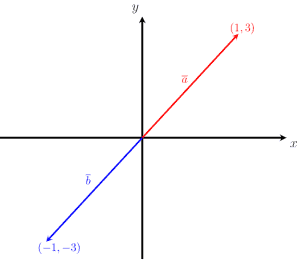
Example 6
Determine the value of x for which the two vectors A = (4, 10) and B = (2x, 5x) are the negatives of each other.
Solution
We know that two vectors are the negatives of each other if their magnitudes are the same and their directions are opposite to each other. We use this to determine the value of the unknown x as follows:
A = – B => (2, 10) = – (2x, 5x)
By setting the corresponding components equal to each other, we get:
2 = -2x
And
10 = -5x
By simplifying the above equation, we get:
x = -2
Thus, when x = -2, the two vectors A and B are the negatives of each other.
Example 7
Determine the value of n for which the two vectors A = (-5, -1, 3n) and B = (-5, -1, -9) are the negatives of each other.
Solution
We know that two vectors are equal if their magnitudes are the same and their directions are opposite to each other. We use this to determine the value of the unknown n as follows:
A = – B => (-5, -1, -3n) = – (-5, -1, -9)
By setting the corresponding components equal to each other, we get:
-5 = 5, -1 = 1, and 3n = 9
-3n = -9
By simplifying the above equation, we get:
n = 3
Thus, when n = 3, the two vectors A and B are the negatives of each other.
Practice Questions
Find the negatives of the following vectors:
- A = (-1, -2/3, 0)
- T = (0, 2, -1)
- V = (2, 5) and D = (3, -2). Also, check if the two vectors are the negatives of each other or not.
- F = (4, 10), G = (5, 5), and H = (-4, -10). Also check if the given vectors are the negatives of each other or not.
- Determine the value of n for which the two vectors A = (-2n, -3, -2) and B = (8, 3, 2) will be the negatives of each other.
- Vector OA with starting point O = (-1, 0, 3) and ending point A = (5, 2,0)
- Vector UV, where U = (1, -2, 0) and V = (-2, 2, 0).
Answers
- The negative of the vector A will be –A = (1, 2/3, 0).
- The negative of the vector T will be –T = (0, -2, 1).
- The negative of the vector V will be –V = (-2, -5), the negative of the vector D will be –D = (-3, 2). Clearly, the two vectors are not the negatives of each other.
- The negative of the vector F will be –F= (-4, -10). The negative of the vector G will be –G = (-5,-5), and the negative of the vector H will be –H = (4,10). Clearly, the two vectors F and G are not the negatives of each other, but the vectors F and H are F = – H.
- By comparing the components of two vectors, we find that, when n = 4, the two vectors, A and B, will be the negatives of each other.
- The vector OA’s magnitude is |OA|= 7 units, and the negative of the vector OA will be –OA. Its magnitude should be the same as that of vector OA. Thus, the vector –OA will start at the point -O = (1, 0, -3) and end at the point -A = (-5, -2, 0).
- The magnitude of the vector UV is |UV|= 5 units, and the negative of the vector UV will be –UV. Its magnitude should be the same as that of vector UV. Thus, the vector –UV will start at the point -U = (-1, 2, 0) and end at the point -V = (2, -2, 0).
